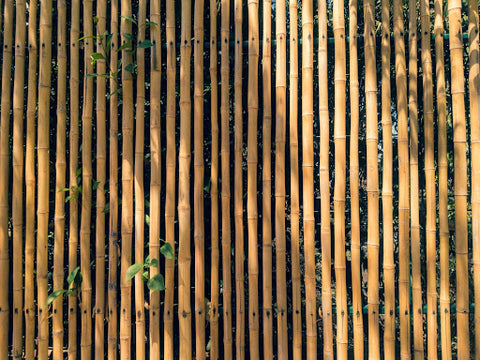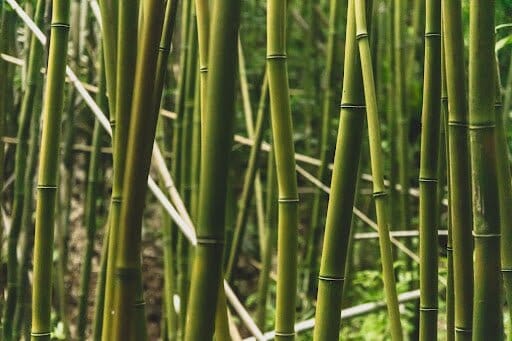Bamboo is a one-of-a-kind plant that can only be described as a gift from nature. It’s one of the most versatile plants in the world and it's used for hundreds of different things—from food to furniture to buildings.
There is a lot of innovation surrounding bamboo, and its unique properties are what’s driving these new products. In this blog, we’re doing a deep dive into the wide variety of things we can do with bamboo. We’ll also touch on its most amazing properties—like its ability to sequester carbon dioxide.
Ultimately, we want to answer the question “is baboo sustainable?”
Let’s find out!
What is Bamboo?
Bamboo is a tree-like grass native to Asia and South America but it can also be found in Africa, Australia, and even North America. Its ability to grow in challenging climates and conditions allows for it to grow pretty much anywhere.
Bamboo is a very unique crop with properties that make it a sustainable staple. It’s fast-growing, needs very little water, and no pesticides to grow. Plus, once harvested, it regenerates itself—meaning it doesn't have to be re-planted. The root system continues to grow new bamboo shots, even after it has been harvested.
What Can We Do With Bamboo?
Bamboo is extremely versatile and has hundreds of uses. Asia has been tapping into the many different ways to use bamboo for thousands of years. Bamboo shoots are actually food. It’s used in construction, to make everyday items like mugs and plates, and much more.
As bamboo grows in popularity, you might have seen new products using it, like toothbrushes, straws, and reusable cutlery. But there is a lot more that can be done with bamboo. These are some of its main uses.
Buildings, Houses, and Virtually Any Construction

Yes, you read that right—bamboo is an enduring construction material. Houses made using bamboo can actually withstand an earthquake. This is mainly because of its tensile strength, which is stronger than steel.
Steel’s tensile strength is 23,000 pounds per square inch, which is child’s play for bamboo’s 28,000 pounds of tensile strength.
Because of this, raw bamboo is used to build bridges, houses, roads, buildings, and even plumbing. Many countries rely heavily on bamboo for their construction needs. And the environmental impact of bamboo constructions is minimal compared to other materials like timber and concrete.
Bamboo is also an outstanding material for furniture and home goods. Our friends at Bamboo Revolution are using bamboo to enhance homes, creating everything from flooring and countertops to tables and chairs.
Bamboo Paper
Bamboo is becoming a popular source for making paper—everything from printer paper to TP! This is a huge area of opportunity. Paper is an essential everyday item but its production is one of the greatest causes of deforestation, and bamboo could replace timber across many industries, including paper.
Switching to bamboo paper would mean slowing down deforestation and relying on the most carbon-negative plant in the world to make such an essential resource.
Everyday Items

Besides clothing, buildings, roads, plumbing, and paper—bamboo is also a staple for many everyday items. You can find bamboo straws, cutlery, toothbrushes, plates, chopsticks, and a lot more. Most of these items use raw bamboo, meaning they’re biodegradable and compostable.
Bamboo Fabric (aka Rayon)
Bamboo fabric is exploding in popularity and many are calling it the greatest eco-fabric out there. The problem is that they’re attributing the plant’s sustainable characteristics to the fabric—and there is more to it than that.
Bamboo goes through a very intensive process to be turned into fabric and unfortunately, that process relies heavily on toxic chemicals. The fact that bamboo fabric comes from a sustainable source doesn't make it sustainable.
So, bamboo fabric isn’t sustainable?
Well, kinda. There are two different ways to make bamboo fabric—one of them uses a lot of unrecyclable toxic chemicals. The other one is called the lyocell fiber method which is closed-loop, meaning all chemicals are recycled and is therefore much more sustainable, but it's still not perfect.
Either way, rayon and lyocell are both biodegradable, which is a great eco-advantage. And the process of creating rayon is also improving. New techniques for recycling the chemicals used in the process are progressing quickly, and as technology improves, sustainability will follow.
What Makes Bamboo So Cool?
Quite a few things, actually! Bamboo has many qualities that make it a one-of-a-kind plant. And we’re constantly discovering more and more properties—allowing for innovation and new products.
One of the most interesting things about bamboo is its super fast-paced growth. It’s the fastest-growing plant with wood-like qualities on the planet.
Bamboo grows at an unmatchable rate and can reach a 1.5/inch per hour growth rate. Plus, it only needs 3-5 years to reach harvest size. This is remarkable since timber takes at least 20 years to grow to maturity, making bamboo a much better and more sustainable option.
Along with its fast-paced growth, bamboo is exceptional at carbon sequestration while also releasing 35% more oxygen than trees. A single hectare of bamboo can sequester up to 17 tonnes of carbon yearly—5 times more than pine trees.
Bamboo needs very little to thrive. It uses very little water to grow and doesn’t need pesticides. Plus, its root system can actually help restore damaged soil and prevent erosion. Unlike most crops, when you harvest bamboo, it regenerates and grows again. Harvesting doesn’t kill it.
Is Bamboo Sustainable?

As a crop, bamboo is one of the most environmentally friendly plants out there. It has very little water needs, grows fast, doesn’t need pesticides, and sequesters more CO2 than trees.
But this doesn’t mean that everything that’s made from bamboo is sustainable. Clearing forests to make space for intensive bamboo farming isn’t sustainable. Processing bamboo using toxic chemicals and unrecyclable materials isn’t sustainable either. Many bamboo products use glues and toxic chemicals, so the sustainability impact really depends on how it's being used.
As with virtually anything, you need to make sure the bamboo products you buy are created consciously and sustainably.
There is a lot of sustainable potential in bamboo and we’re excited to see what we can responsibly create from it.
How We’re Tapping into Bamboo
We’ve always been committed to tapping into the potential of natural ingredients for our products. And bamboo is no exception. As we work on creating the world’s most sustainable hat, we're using bamboo in our patent-pending all-natural brim construction. It’s made of cork and bamboo and it’ll be 100% plastic-free—the first of its kind.
Stay tuned for the launch by subscribing to our email list. We’ll be having monthly member-exclusive giveaways you don’t want to miss out on!
